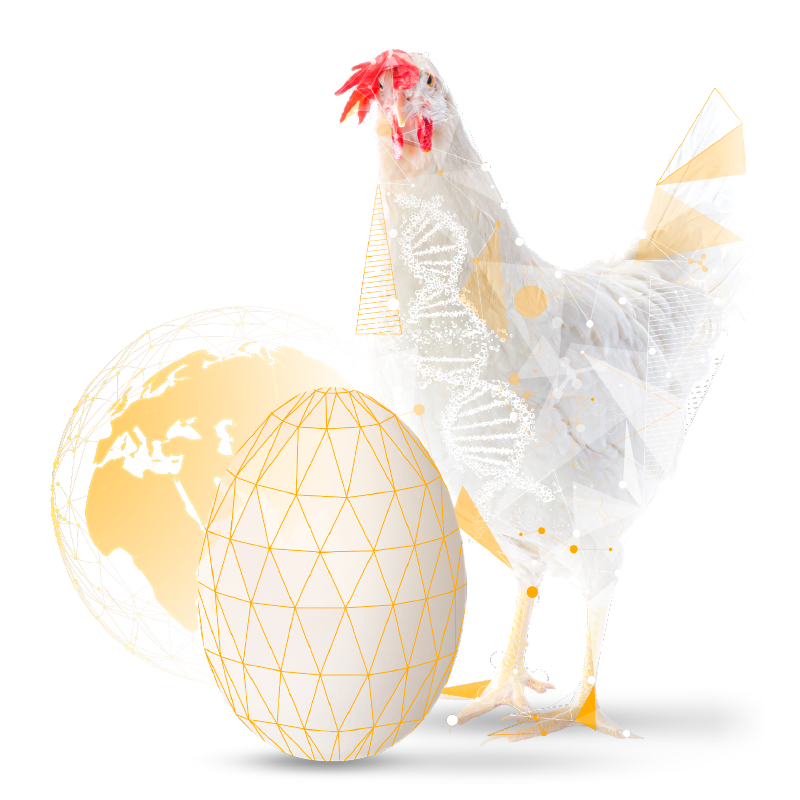Summary
Two random sample tests in Germany were designed to compare the performance of six strain crosses
under conditions of enriched cages and floor management.
The analysis of variance confirmed highly significant differences between strains and between testing
stations. Egg income over feed cost in the enriched cage system was almost 2 EUR per hen higher
than in the floor management system.
Statistically significant interactions were only found for hen-day egg production. This interaction was
explained by the observation that the white-egg strain LSL Classic laid almost the same number of eggs
in both systems, whereas the brown-egg strains “lost” between 9 and 28 hen-day eggs in the floor
system compared to enriched cages.

Introduction
Official random sample tests (RST) were organized in Germany during the 1960s and served egg producers as an independent source of information on the performance of different strains of hybrid layers. Over the years, the management of these tests was modified to reflect commercial management of laying hens as much as possible. These tests stimulated global competition among the leading primary breeders (Tixier-Boichard et al. 2012). Results from different tests were subjected to statistical analyses across several years to get more reliable estimates of genetic differences (e.g. Heil and Hartmann 1997) and to estimate time trends (Flock and Heil 2002). Egg producers used to be able to choose a strain on the basis of results from individual tests obtained under similar conditions as on their own farm (similar beak treatment, lighting program and nutrition), or they could draw conclusions from more reliable summaries. Most tests in Germany and other countries have been discontinued since the 1990s. Concentration of primary breeding has led to a situation today where two global players dominate the world market, each with a range of different white-egg and brown-egg strains (Lohmann Tierzucht in Germany and Hendrix Genetics in The Netherlands), while two small breeding companies (Babolna with Tetra in Hungary and Hubbard with Novogen in France) are trying to increase their market shares. In the late 1960s and early 1970s, when testing stations in Germany changed from floor management to conventional cages, a similar question was raised as currently with the change from conventional cages to enriched cages and floor systems: are some strains better adapted to floor conditions, while other strains perform better in modern cage systems? A direct comparison at Eickelborn (1973/74) suggested that HNL Nick Chicks performed relatively better under floor conditions, whereas other white-egg strains performed better in cages. In 2010/11, two random sample tests in Germany were jointly planned to look again at possible interactions between strains and management systems, this time with floor vs. enriched cages. The individual results of each station have been published in DGS 18/2012 und 22/2012. In the present summary, we will examine the strain differences under conditions of floor management (Kitzingen) vs. enriched cages (Kleingruppenhaltung) in Haus Düsse, with focus on the practical question: which combination of strain and management offers the best overall results?Data
Hatching eggs from 6 strain crosses were supplied to the testing station Kitzingen, where all chicks hatched 08/04/2010 and were reared under identical floor conditions to 18 weeks (126 days). At this age, 496 pullets per strain (4 pens with 124 each) were housed in Kitzingen, 120 pullets per strain transported to Haus Düsse, where they were housed in a Eurovent Big Dutchman unit of enriched cages (6 replicates with 20 hens each). All pullets were beak treated at 10 days of age. The rearing unit was equipped with A-frames, feed and water was offered ad libitum at elevated levels. The lighting program during rearing followed commercial standards, light intensity was kept at levels required by German poultry welfare regulations. All records were kept per replicate: for egg production, feed intake and mortality on a daily or weekly basis, for egg quality traits on a sample basis; details have been published in previous reports. The design of the two simultaneous tests is shown in table 1.Table 1: Design of Test
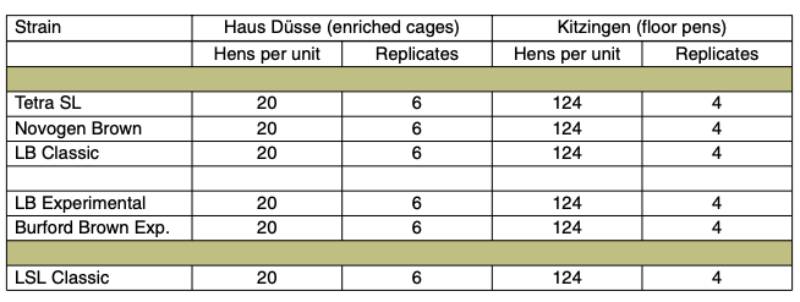
Statistical analysis of data and summary of results
The individual records per replicate (60 experimental units) were analyzed with standard SAS software, treating testing stations (T) and strains (S) as fixed effects; the model is shown at the bottom of table 2. Highly significant differences (P<1%) were found between testing stations for all traits except egg weight. Strain differences were also highly significant for all traits except mortality (P<5%). A significant interaction was only found for hen-housed egg production. As indicated by the R² values in the last line of table 2, the repeatability of results between replicates of the same strain in the same test varied considerably between traits: 93% of the variation in hen-housed eggs, but only 44% of the variation in mortality could be explained by the model, i.e. between 56% (mortality) and 7% (HH egg production) of the variation was “random”.Table 2: Analysis of variance with F-test for significance of main effects and interaction1)

The F-values from the analysis of variance indicate which traits were most or least affected by the factors in the model. For example, differences between testing stations were most important for feed conversion ratio and egg income minus feed cost and negligible for egg weight; differences between strains were most important for hen-housed egg production and least important for mortality.
Differences in performance due to management system
The environment in which the hens were tested can be characterized in terms of management system, group size, lighting conditions and nutrition. The experimental Big Dutchman Eurovent unit in Haus Düsse meets EU requirements for enriched cages and is a modification of German requirements for Kleingruppenhaltung (KGH): it has perches on one level (Germany requires two levels)and 20 hens in 1.6 m² cages (Germany requires at least 2.5 m² for 30-60 hens) with 800 cm² per hen. In Kitzingen, two floor systems were used for the test: Fienhage and Big Dutchman, both with 8 hens/m², average pen size 15.5 m², and 124 hens per section. The lighting programs during the laying period were identical („step-up“ from 9L:15D at 18 weeks to 14L: 10D at 24 weeks of age), whereas the floor unit in Kitzingen had no control over seasonal changes in natural day length and daily light intensity (tinted window, 3% of floor space), whereas Haus Düsse had a windowless house with controlled light intensity and vertically installed high frequency fluorescent tubes. In Haus Düsse, the same all-mash layer feed was provided ad libitum in troughs during the entire testing period (17.5 % CP, 0.4% Meth., 11.6 MJ ME and 3.6% Ca), whereas Kitzingen had a pan feeding system and applied phase feeding as follows:Phase 1 (18-48 weeks of age): 18.0 % CP, 0.42% Meth.; 11.6 MJ ME and 3.75% Ca. Phase 2 (49-72 weeks of age): 17.5 % CP, 0.40% Meth.; 11.4 MJ ME and 3.85% Ca.
Table 3: Trait means per testing station and significance of difference
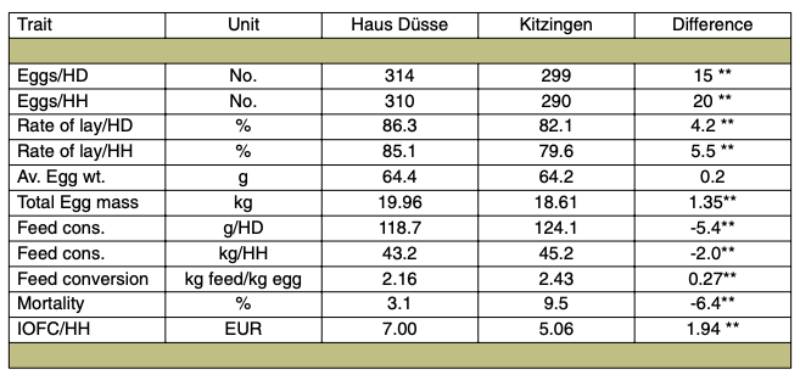
Table 3 shows the means per station and average differences between testing stations. The difference in hen-housed egg number (20 eggs) in favor of the cage system in Haus Düsse is partly explained by the higher mortality under floor conditions in Kitzingen, but hen-day production also differs by as much as 15 eggs. Feed consumption differed by 2 kg per year or 5.4 g per hen-day, which is partly explained by lower energy in phase 2 feed and more exercise in the floor systems at Kitzingen. Other possible factors for which we cannot offer quantitative data are different house temperature, feather loss, feed wastage and uncollected eggs laid outside the nests in floor systems. Total mortality in the cage system at Haus Düsse was low (3.1%) and mainly due to egg peritonitis (10 out of 22). Total mortality in the floor system at Kitzingen was three times as high, mainly due to cloaca pecking and cannibalism (60% of total mortality), followed by peritonitis and bacterial infections. Egg income minus feed cost was 7.00 EUR in Haus Düsse vs. 5.06 EUR in Kitzingen. This difference is statistically highly significant and relevant for commercial egg production. Less dust in the laying house and separation of the hens from their droppings in the cage system minimizes the risk of infection and recontamination. This explains why no losses in Haus Düsse were diagnosed as due to bacterial infections. The small group size of 20 hens in the Eurovent system allows the establishment of a fairly stable peck order, and losses due to cannibalism are less likely than in larger units.
Average strain differences for key traits
Least-squares strain means for 8 traits of major interest are summarized in table 4. The statistical significance of differences between strains was tested with a multiple T-test (Tukey test) and confirmed significant differences for all traits except mortality. To establish strain differences in traits with low heritability and repeatability like mortality, many tests with larger numbers of hens per test would be needed.Table 4: Least squares strain means across both testing stations³)
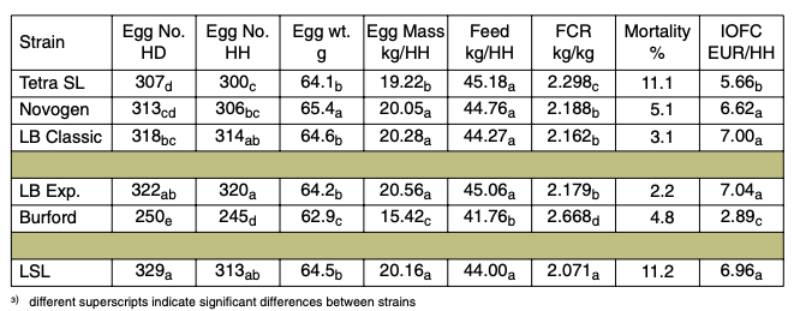
Differences between commercial strains in egg income minus feed cost will be of major interest for egg producers. Since hatching eggs for the experimental LB entry were supplied by the breeding company, the results may suggest the direction of current genetic improvement. The Burford Brown layer is a cross involving the Maran breed to produce chocolate brown eggs for a niche market which is prepared to pay a premium price to recover the higher production cost per egg.
Interaction between strains and test environments
According to the results of analysis of variance shown in table 2, interactions between testing stations and strains were only significant for hen-day egg production (*p< 5% ). For all other traits, the changes in ranking were negligible. Table 5 shows the difference in hen-day egg number between testing stations for each strain.Table 5: Significant TxS interaction for hen-day egg production

Discussion
The obvious conclusion from this analysis is that differences between management systems were more important than differences between commercial strains, except for highly heritable traits like egg weight. This may be of interest for egg producers outside Germany who are still free to decide in which system to invest to comply with current EU regulations and trends in other countries to replace conventional cages. Egg producers in Germany, however, who are no longer free to invest in modern cage systems, need to know which strains are coping better with existing floor systems, especially in terms of saleable eggs per hen housed and feed efficiency.Assuming that mortality is accepted as a relevant criterion for hen wellness, we can expect breeding companies and equipment companies to focus on reduced mortality and nesting behavior. Competition among primary breeders (and different strain crosses of the same breeder) will continue, while equipment companies will offer a range of solutions which promise to harvest as many salable eggs as possible from a given unit. Interaction studies like the present test can contribute useful information and should be repeated with technical solutions which have shown promising results in practice. Experiment stations must be free to deviate from national regulations if the design is likely to reduce mortality. Mortality will not always be as low as found in Haus Düsse, but if 3.1% can be achieved with 20 hens per unit of enriched cages, we should not accept 9.5% as a price to be paid for “hen welfare” according to German regulations. Common causes of high mortality in floor systems are known, and they should be taken into account when regulations are critically reviewed on the basis of international experience with alternative designs.
It may be of interest to compare present results with a similar test almost 30 years when German random sample tests changed from floor management to cages. In 1973/74 the Station at Eickelborn compared 12 white-egg and 17 brown-egg entries in both systems, before the floor test was terminated. All pullets were beak-treated at 8 days of age and reared in separate floor pens to measure feed intake per entry. For the laying period, 2 floor pens per entry were used with 50 pullets at a density of 4.5 per m²; 80 pullets per entry were housed in 4-bird cages at 492 cm² bird density, with replicates of 20 birds randomly distributed in the house. Results for 4 white-egg and 6 brown-egg strains are shown in table 6.
Table 6: Floor vs. cage performance of 10 strains in RST Eickelborn 1973/74
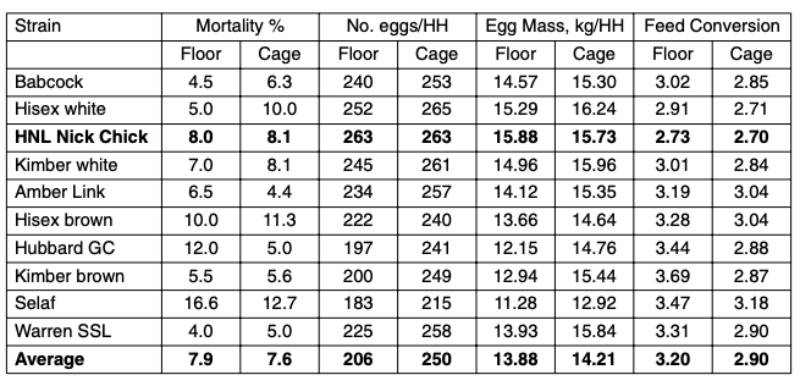
Similar to the LSL entry in the 2010/11 tests, the HNL strain had essentially the same performance in both systems, whereas other strains probably “lost” some eggs in the floor system which had been laid outside the nests, but could not be collected from the litter. In this historical test, cannibalism was negligible, and differences in total mortality could not explain the lower hen-housed egg production.
References
Flock D.K. and G. Heil (2002): Eine Langzeitanalyse der Leistungsentwicklung weißer und brauner Legehybriden anhand von Ergebnissen der amtlichen deutschen Legeleistungsprüfung von 1974/75 bis 1997/99. Archiv für Geflügelkunde 66,1-20.Heil G. and W. Hartmann (1997): Combined Summaries of European Random Sample Tests Completed in 1995 and 1996.
World Poultry Sci. J. 53, 291-293.
Urselmans, S. and K. Damme (2012): 9. Bayerischer Herkunftsvergleich von Legehybriden. DGS MAGAZIN 18,10-16.
Simon, I. and J. Stegemann (2012): 1. Nordrhein Westfälischer Herkunftsvergleich von Legehybriden in Kleingruppenhaltung. DGS MAGAZIN 22, 27-32.
Tixier-Boichard M., F. Leenstra, D.K. Flock, P.M. Hocking and S. Weigend (2012): A century of poultry genetics. World Poultry Sci. J. 68, 307-321.
Zusammenfassung
Untersuchungen zur Anpassungsfähigkeit verschiedener Legelinien an Käfig- und Bodenhaltung: Ergebnisse deutscher Legeleistungsprüfungen 2010/11 mit einem Rückblick auf 1973/74Junghennen von 6 Herkünften wurden nach gemeinsamer Aufzucht in Kitzingen auf zwei Gruppen für die Legeleistungsprüfung aufgeteilt: Bodenhaltung in Kitzingen und Kleingruppenhaltung in Haus Düsse. Die pro Untergruppe erfassten Daten wurden in Kitzingen varianz-statistisch ausgewertet und brachten folgende Ergebnisse:
(1) mit Ausnahme des hoch erblichen durchschnittlichen Eigewichts wurden in der Käfiganlage signifikant bessere Ergebnisse erzielt als in Bodenhaltung (Tab. 3).
(2) abgesehen von einer Versuchskreuzung waren die Unterschiede zwischen den Linien geringer als zwischen den Haltungssystemen (Tab. 4).
(3) Wechselwirkungen waren nur für das Merkmal Eizahl je Durchschnittshenne signifikant (Tab. 5). Zum Vergleich werden Ergebnisse aus 1973/74 angeführt (Tab. 6). Schlussfolgerungen für politische Rahmenbedingungen, Praxis und Wissenschaft werden diskutiert.






